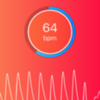I work for the Hillsboro School District in a trauma-informed elementary school in Hillsboro Oregon. Our school is one of the fortunate 13 schools in our district to have a wellness program. This is my second year as the wellness instructor at Free Orchards Elementary. The basis for our program comes from the following top notch publication:
Fostering Resilient Learners by Kristen Souers and Pete Hall
The primary emphasis in our program is on the curriculum presented in the ZONES of Regulation, written by Michelle Garcia Winner. Both of these publications contain valuable insights and tremendous guidance which train and inform the instincts of educators who have a heart for this work.
This year I came up with an effective strategy using an app on my iPhone. I have been focusing on third through sixth graders, demonstrating to them how their heart rate tells a story about how they are feeling in response to external stimuli. I show them through a series of three experiments which measure their heart rate under three different circumstances. We do the experiments using an app called “Cardiio” on iPhone. (I have also been showing some students how to check their own heart rate anytime on their own with the second hand on the clock.) The highly rated free app shows them visibly their heart as it beats, just like what you see on a heart monitor in the hospital. At the end of 15 seconds, it gives you a BPM result.
We take three readings. The first one is when they are calm, which gives us a baseline. The second reading is "while being annoyed"… Like, with me poking them in the forehead, repeatedly, or while I, possibly along with other students are making loud noises. (Of course, this torture is with their permission, which they are glad to grant) With some students, the second reading is just after they run back-and-forth across the room several times, do push-ups or vigorous jumping jacks.
Then, the third reading is after they have done relaxation techniques, specifically, controlled belly breathing, (paced by me) followed by laying their head down on the desk. I explain to them that their vestibular system triggers a relaxation response when their head is in the horizontal position. I put the goal before them to try to get their heart rate SLOWER than their first reading. And I let THEM decide when they think it might be a winning score... So it’s up to them to choose the moment they want to get that last reading. It is amazing how carefully they try to assess the feeling in their chest in order to determine when to test their heart for the last reading. The length of time they delay is telling indeed!
When a group of students is involved in this experiment, the spectators’ job is to be quiet during the first reading, annoy the test subject during the second reading, and, during the third reading, participate in HELPING the participant to lower their heart rate by joining in with breathing exercises and laying their heads down (or other relaxation techniques). Even an entire classroom has been involved in this experiment, as they witnessed their teacher’s physiological response to the three circumstances. Their investment in the experiment rose during the 2nd test when their job was to annoy their teacher. But on the last test, their interest increased exponentially when they found out their job was to help their teacher’s heart rate to be lowest on the third round by participating in belly breathing and by laying their heads down on their desks. The group effort was a sight to see, and you could have heard a pin drop! (Their teacher did get her heart rate lower during the last round, by the way! Which we all celebrated!)
Back in the Wellness Center...
ACES: Some of the student participants have had a lot of trauma, and once their stress hormones are released, they’re unable to get their heart rate to slow down. In that case, I explain stress hormones to them and explain how their amygdala plays a role. It is an eye-opener for them. Interestingly, other students - with high ACES, have also had a lot of trauma but they are able to LOWER their heart rate DURING the time I am annoying them!! In this case, I explain to them how they have learned to create an inner calm and have unusual self control when there’s something important going on. I give these students some likely well-deserved credit for this amazing capability. Also very eye-opening to them.
After we are done with these three tests, we have a brief conversation on what it can mean for them. This conversation varies widely depending on the student, but one example is that our energy level as well as our behavior GREATLY impacts those around us. They gain a new understanding of how the “yellow zone” impacts the classroom environment.
This exercise is utterly fascinating to me, as it also is for the students! Many of them have told me that it has put them in the “Flow” (opposite of “Frazzle”) state -which we have also been learning about this year. There are many takeaways from this heart-rate experiment. I am sure you can think of plenty!
-Sabrina Eickhoff, Wellness Instructor at Free Orchards Elementary School, Hillsboro School District, Oregon




Comments (1)